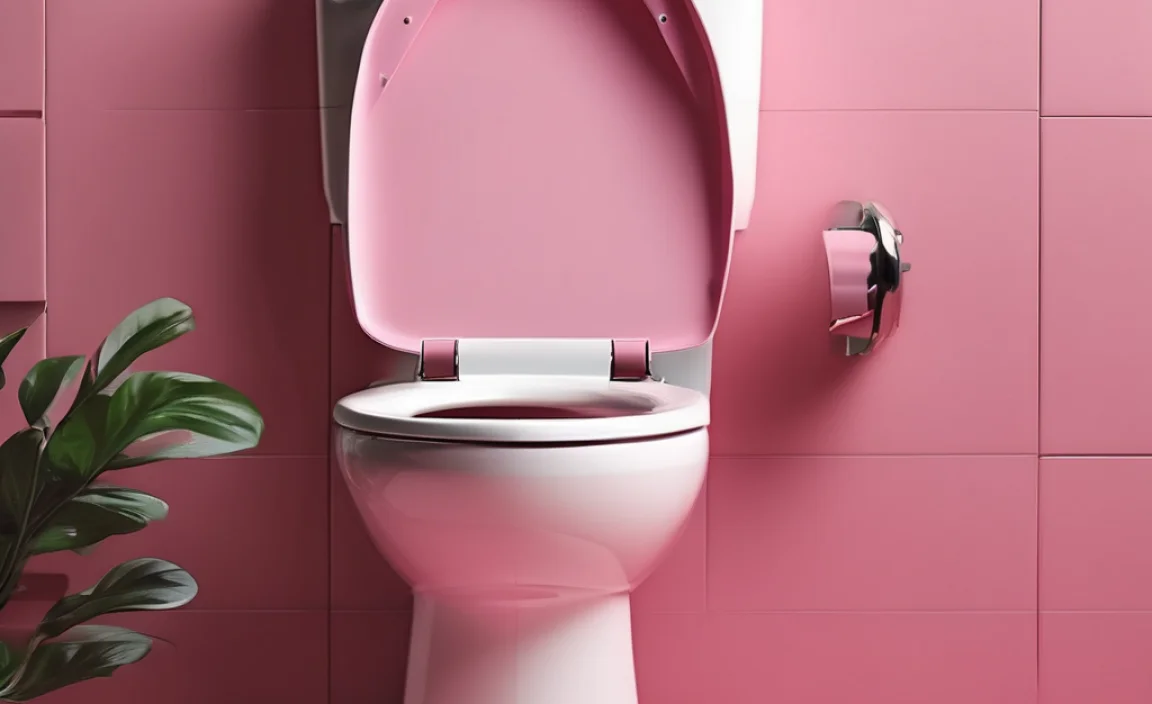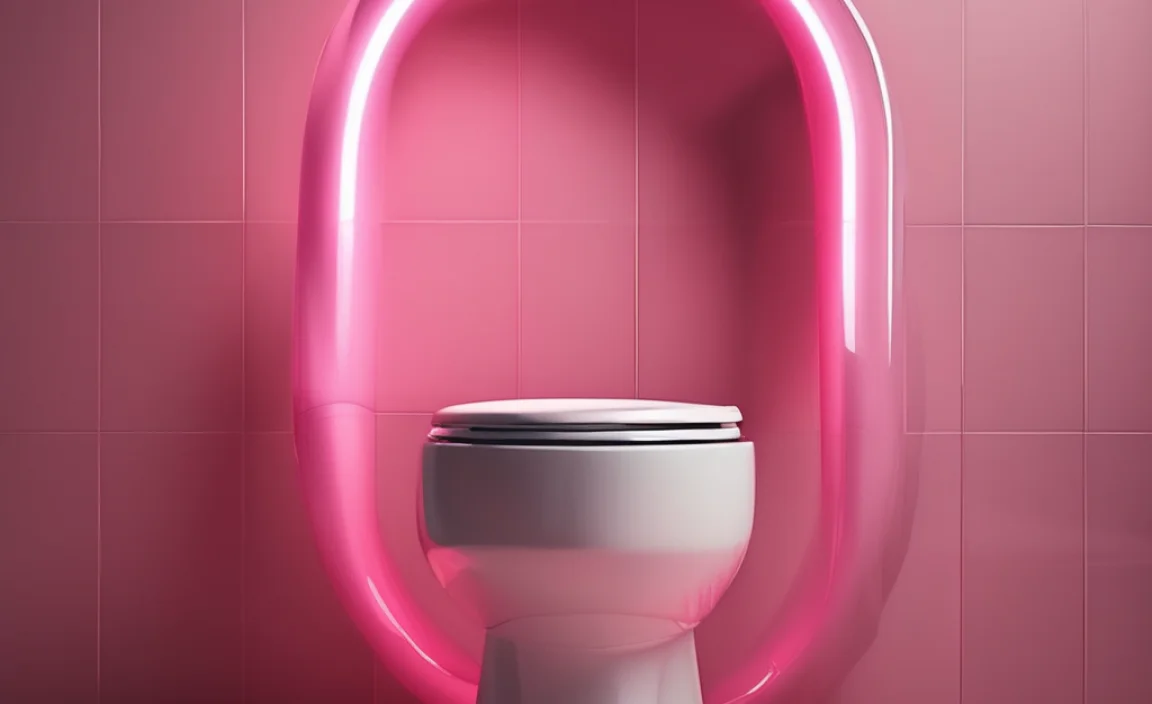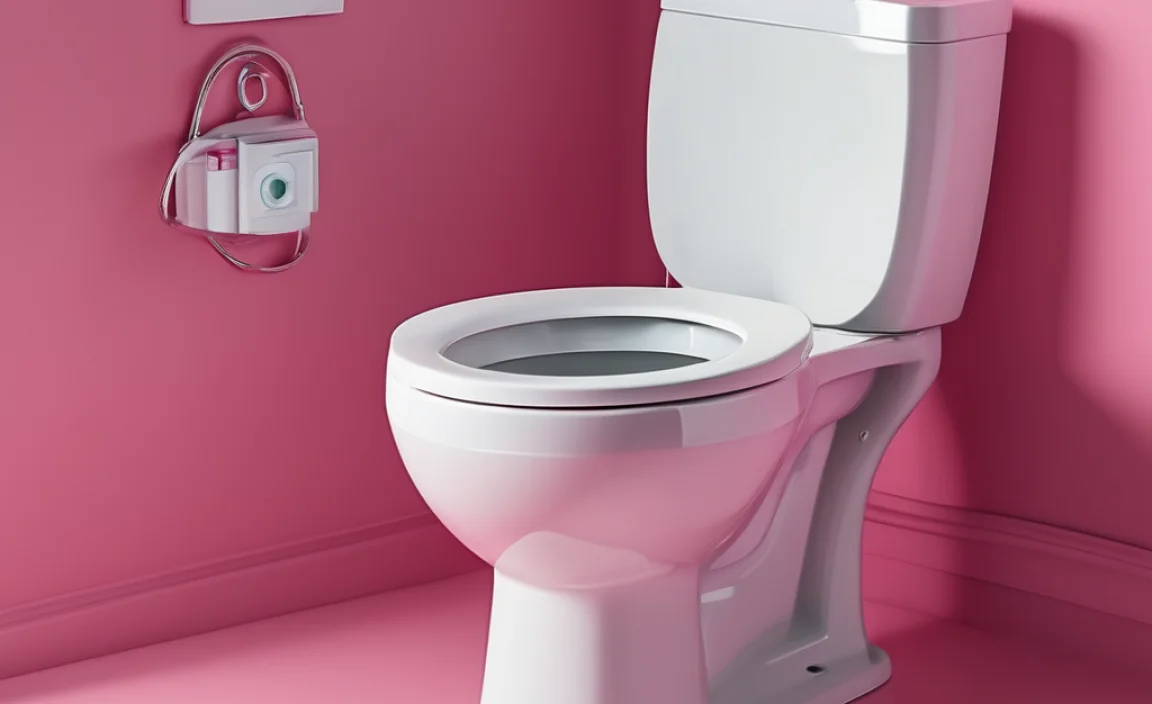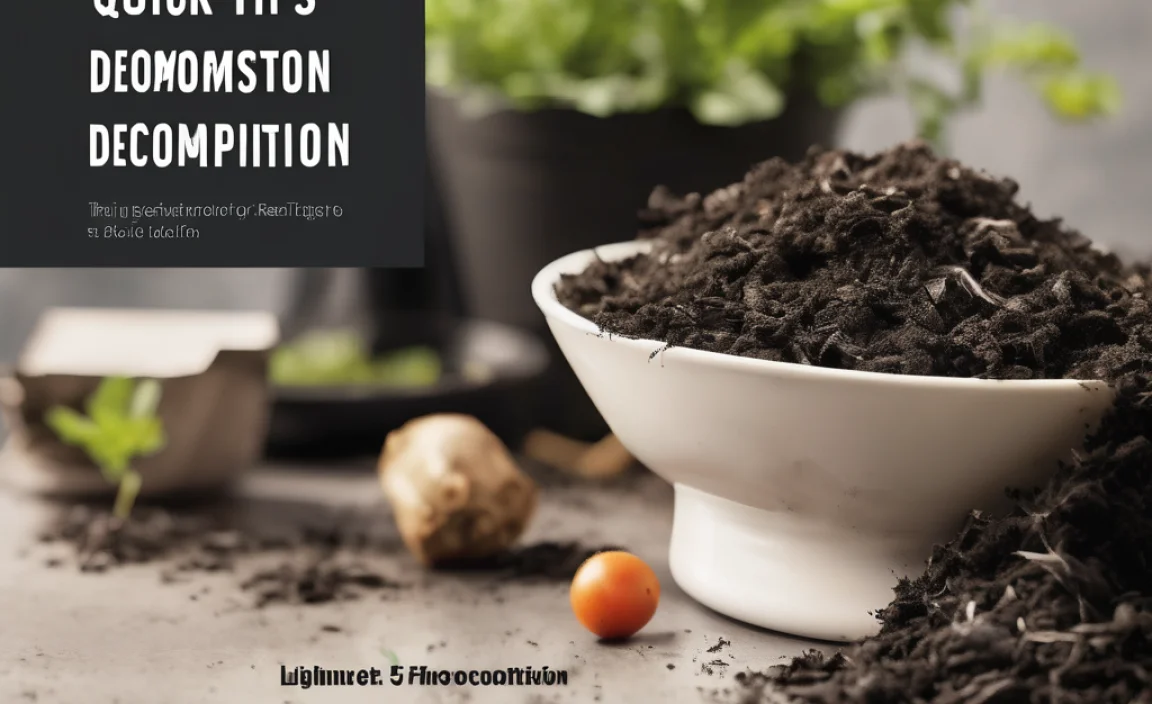Quick Summary: That pink ring in your toilet isn’t dirt! It’s usually a bacteria called Serratia marcescens. Harmless to most, it thrives in damp places. Regular cleaning with bleach-based products, keeping your toilet bowl clean, and ensuring good ventilation will usually keep it at bay.
Seeing a pink ring in your toilet bowl can be a bit of a shock. It looks like stubborn dirt, but no matter how hard you scrub, it keeps coming back. What is this stuff? Don’t worry, you’re not alone! Many homeowners face this. The good news is, it’s usually not a serious problem, and you can get rid of it pretty easily.
We’ll walk you through what causes that pesky pink ring and give you simple, step-by-step instructions on how to eliminate it. Plus, we’ll share tips to prevent it from returning. Let’s get started and make your toilet bowl sparkling clean!
Understanding the Pink Ring in Your Toilet

Before we dive into cleaning, let’s understand what we’re dealing with. It’s not mold or algae, but a common bacteria called Serratia marcescens.
What is Serratia marcescens?
Serratia marcescens is a type of bacteria that’s naturally found in the environment. It loves damp places, which is why it often shows up in your bathroom. It produces a reddish-orange pigment, which creates the pink or sometimes orange ring you see in your toilet, shower, or even pet water bowls.
Why Does it Grow in Toilets?
Toilets offer the perfect conditions for Serratia marcescens to thrive:
- Moisture: Toilets are constantly filled with water, providing the dampness these bacteria love.
- Nutrients: The bacteria feed on minerals and organic matter found in water and the air.
- Still Water: Areas with stagnant water, like the toilet bowl, encourage bacterial growth.
Is the Pink Ring Harmful?
For most healthy people, Serratia marcescens is generally harmless. However, in rare cases, it can cause infections, especially in people with weakened immune systems or those in hospital settings. It’s always a good idea to take precautions and keep your bathroom clean.
Factors Contributing to Pink Ring Formation

Several factors can increase the likelihood of that pink ring appearing in your toilet:
- Airborne Bacteria: Serratia marcescens is airborne, so it can easily travel into your bathroom through open windows or ventilation systems.
- Water Source: Well water or water with high mineral content can provide extra nutrients for the bacteria to feed on.
- Infrequent Cleaning: If you don’t clean your toilet regularly, the bacteria have more time to multiply and form that noticeable ring.
- Poor Ventilation: Bathrooms with poor ventilation tend to stay damp, creating an ideal environment for bacterial growth.
Step-by-Step Guide to Removing the Pink Ring

Now that you know what causes the pink ring, let’s get rid of it! Here’s a simple, step-by-step guide.
What You’ll Need
- Toilet bowl cleaner (bleach-based is most effective)
- Toilet brush
- Rubber gloves
- Eye protection (optional, but recommended)
- Clean cloth or sponge
- Spray bottle (optional)
- White vinegar (optional, for milder cleaning)
Step 1: Protect Yourself
Put on your rubber gloves and, if you prefer, eye protection. This is important to protect your skin and eyes from the cleaning products.
Step 2: Apply Toilet Bowl Cleaner
Squeeze the toilet bowl cleaner around the inside of the bowl, focusing on the pink ring. Make sure to coat the entire affected area.
Step 3: Let it Sit
Allow the cleaner to sit for at least 10-15 minutes. For tougher stains, you can let it sit longer, even overnight. The longer it sits, the better it will break down the bacteria.
Step 4: Scrub Thoroughly
Use your toilet brush to scrub the entire bowl, paying extra attention to the pink ring. Apply some elbow grease to make sure you remove all traces of the bacteria.
Step 5: Flush
Flush the toilet to rinse away the cleaner and the loosened bacteria. Check to see if the pink ring is completely gone. If not, repeat steps 2-4.
Step 6: Wipe Down the Exterior
Use a clean cloth or sponge to wipe down the exterior of the toilet, including the seat, lid, and base. This helps prevent the bacteria from spreading to other surfaces.
Alternative Cleaning Methods
If you prefer a more natural approach, here are a couple of alternative cleaning methods:
- White Vinegar: Pour a cup of white vinegar into the toilet bowl and let it sit overnight. Scrub and flush in the morning. Vinegar is a natural disinfectant and can help remove mild stains.
- Baking Soda and Vinegar: Sprinkle a cup of baking soda into the toilet bowl, then pour in a cup of white vinegar. Let it fizz for about 30 minutes, then scrub and flush. This combination can help lift stains and kill bacteria.
Preventing the Pink Ring from Returning

Getting rid of the pink ring is just half the battle. Here are some tips to prevent it from coming back:
- Regular Cleaning: Clean your toilet at least once a week with a bleach-based cleaner. This will keep the bacteria at bay.
- Flush Regularly: Flush your toilet regularly, even when not in use, to prevent stagnant water.
- Improve Ventilation: Make sure your bathroom is well-ventilated by opening windows or using a ventilation fan. This helps reduce moisture levels.
- Clean Showerheads and Faucets: Serratia marcescens can also grow on showerheads and faucets. Clean them regularly with a bleach solution.
- Consider a Toilet Bowl Cleaner with Bleach: Using a toilet bowl cleaner with bleach regularly can help prevent the pink ring from forming.
- Check Your Water Source: If you have well water, consider testing it for bacteria and minerals. You may need to install a water filter to reduce the nutrient supply for the bacteria.
Choosing the Right Cleaning Products

Selecting the right cleaning products can make a big difference in preventing and removing the pink ring. Here’s a comparison of some popular options:
| Product Type | Pros | Cons | Best For |
|---|---|---|---|
| Bleach-Based Cleaners | Effective at killing bacteria, removes stains quickly | Can be harsh, strong odor, may discolor surfaces | Heavy-duty cleaning, severe pink ring issues |
| Vinegar | Natural, non-toxic, readily available | Less effective on tough stains, may require longer soaking | Mild cleaning, regular maintenance, eco-friendly option |
| Baking Soda | Gentle abrasive, deodorizes, non-toxic | Not as effective on its own, requires combining with vinegar | Light cleaning, deodorizing, safe for all surfaces |
| Commercial Toilet Bowl Cleaners | Formulated for toilet cleaning, often scented | Can contain harsh chemicals, may be expensive | Regular cleaning, convenience, pleasant scent |
Dealing with Persistent Pink Rings
Sometimes, despite your best efforts, the pink ring keeps coming back. Here are some strategies for dealing with persistent cases:
Increase Cleaning Frequency
If you’re only cleaning your toilet once a week, try increasing it to twice a week. This will help prevent the bacteria from building up.
Use a Stronger Cleaner
If milder cleaners aren’t working, switch to a bleach-based cleaner. Be sure to follow the instructions carefully and wear protective gear.
Soak Overnight
For stubborn stains, try soaking the toilet bowl overnight with a strong cleaner. This will give the cleaner more time to break down the bacteria.
Check for Hidden Sources
Sometimes, the bacteria can be coming from other sources, such as your showerhead or faucet. Clean these areas regularly to prevent the bacteria from spreading.
Consider Professional Help
If you’ve tried everything and the pink ring still persists, it may be time to call a professional cleaner or plumber. They can help identify the source of the problem and recommend a solution.
The Role of Water Quality
Your water quality can play a significant role in the formation of the pink ring. Here’s what you need to know:
Well Water vs. City Water
Well water is more likely to contain minerals and bacteria that can contribute to the growth of Serratia marcescens. City water is usually treated to remove these impurities, but it can still contain trace amounts.
Hard Water
Hard water, which is high in minerals like calcium and magnesium, can also contribute to the formation of the pink ring. These minerals provide nutrients for the bacteria to feed on.
Testing Your Water
If you suspect that your water quality is contributing to the problem, consider testing your water. You can purchase a water testing kit online or hire a professional to test your water for you. The Environmental Protection Agency (EPA) provides guidelines for safe drinking water.
Water Softeners and Filters
If you have hard water or well water, consider installing a water softener or filter. These devices can help remove minerals and bacteria from your water, reducing the nutrient supply for Serratia marcescens.
Advanced Solutions for Stubborn Cases
Sometimes, simple cleaning methods aren’t enough to get rid of the pink ring. Here are some advanced solutions to consider:
Hydrogen Peroxide
Hydrogen peroxide is a powerful disinfectant that can kill bacteria and remove stains. Pour a cup of hydrogen peroxide into the toilet bowl and let it sit for 30 minutes. Scrub and flush.
Borax
Borax is a natural mineral that has cleaning and disinfecting properties. Sprinkle a cup of borax into the toilet bowl and let it sit overnight. Scrub and flush in the morning.
Commercial Disinfectants
There are many commercial disinfectants available that are specifically designed to kill bacteria and remove stains. Be sure to follow the instructions carefully and wear protective gear.
Maintaining a Clean Toilet: Long-Term Strategies
Keeping your toilet clean is an ongoing process. Here are some long-term strategies to help you maintain a clean and bacteria-free toilet:
- Establish a Cleaning Routine: Set a regular cleaning schedule and stick to it. Cleaning your toilet at least once a week will help prevent the buildup of bacteria and stains.
- Use Automatic Toilet Bowl Cleaners: Automatic toilet bowl cleaners release a small amount of cleaner with each flush, helping to keep your toilet clean between regular cleanings.
- Install a UV Sanitizer: UV sanitizers use ultraviolet light to kill bacteria in the toilet bowl. These devices can be installed in the toilet tank or directly in the bowl.
- Regularly Inspect Your Plumbing: Check your toilet and plumbing for leaks or other issues that could contribute to moisture and bacterial growth.
FAQ: Pink Ring in Toilet
Here are some frequently asked questions about the pink ring in your toilet:
- What exactly causes the pink ring in my toilet?
- The pink ring is caused by a bacteria called Serratia marcescens. It thrives in moist environments and produces a reddish-orange pigment.
- Is the pink ring harmful to my health?
- For most healthy individuals, Serratia marcescens is not harmful. However, it can cause infections in people with weakened immune systems.
- How often should I clean my toilet to prevent the pink ring?
- Cleaning your toilet at least once a week with a bleach-based cleaner is recommended to prevent the buildup of bacteria.
- Can I use natural cleaning products to remove the pink ring?
- Yes, white vinegar and baking soda can be effective for mild cases. However, bleach-based cleaners are more effective for tougher stains.
- What if the pink ring keeps coming back after cleaning?
- Increase your cleaning frequency, use a stronger cleaner, check for hidden sources of bacteria, and consider testing your water quality.
- Does well water contribute to the pink ring?
- Yes, well water is more likely to contain minerals and bacteria that can contribute to the growth of Serratia marcescens.
- Should I call a professional if I can’t get rid of the pink ring?
- If you’ve tried multiple cleaning methods and the pink ring persists, it may be time to call a professional cleaner or plumber.
Conclusion
The pink ring in your toilet might be unsightly, but it’s usually an easy problem to solve. By understanding what causes it, following a regular cleaning routine, and taking preventive measures, you can keep your toilet bowl sparkling clean and bacteria-free. Remember, a little elbow grease and the right cleaning products can go a long way. Don’t be discouraged if the pink ring returns; just keep up with your cleaning routine, and you’ll keep those pesky bacteria at bay. Happy cleaning!


